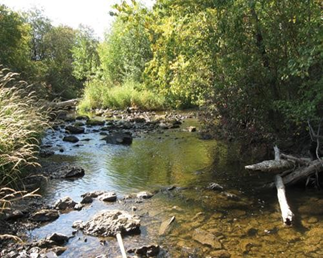Riparian buffers are areas of land, predominantly covered with trees, shrubs, and sometimes grasses, along, and often up-gradient from, streams, watercourses, or water bodies. These natural or restored buffers serve multiple purposes. By maintaining a relatively undisturbed zone adjacent to open water, they play an important role in water quality and flow moderation. Trees and vegetation within in riparian areas can efficiently absorb excess nutrients and may also serve to increase infiltration, and slow water as it moves away from the land, reducing surface runoff and sediment delivery to water bodies.
Additionally, riparian buffers play a crucial role in mitigating drought. They improve groundwater recharge by increasing soil permeability and extending the contact time of water with the soil, thereby enhancing water retention. The shading effects provided by trees and shrubs contribute to creating favourable micro-climatic conditions, reducing evaporation and improving soil moisture levels.
These buffers can be found in a variety of settings, including urban, agricultural, wetland, and forest areas, where they provide essential ecosystem services such as soil stabilisation, water resource protection, and resilience to hydrological extremes.
